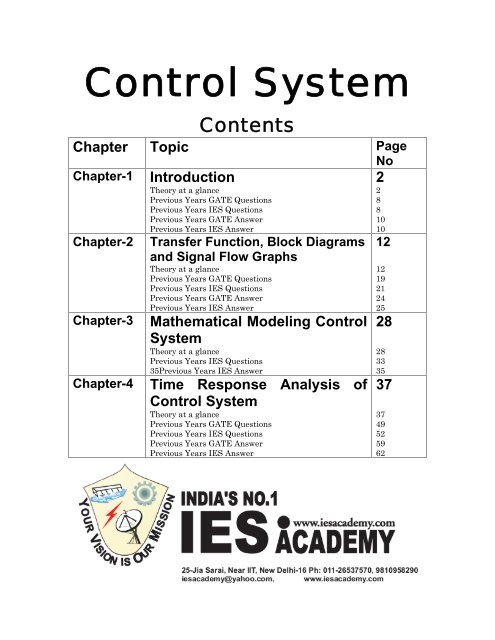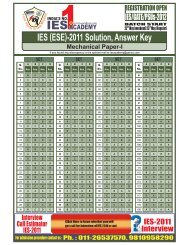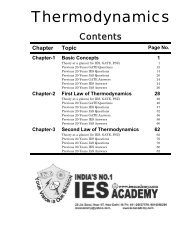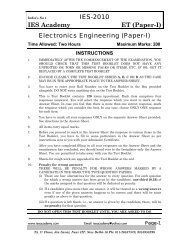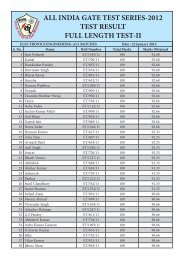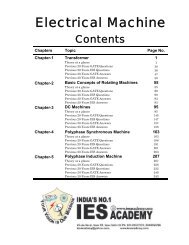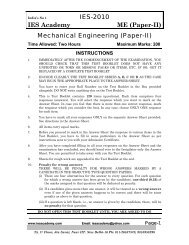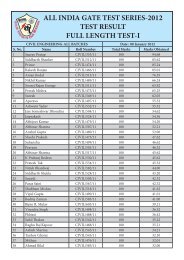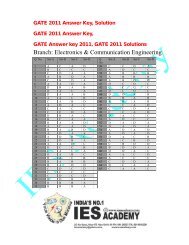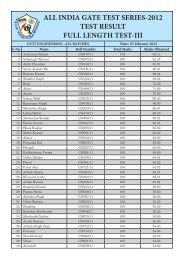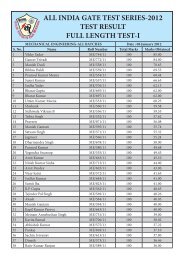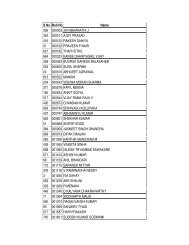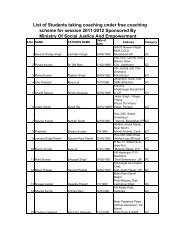Closed-Loop Control System - IES Academy
Closed-Loop Control System - IES Academy
Closed-Loop Control System - IES Academy
Create successful ePaper yourself
Turn your PDF publications into a flip-book with our unique Google optimized e-Paper software.
<strong>Control</strong> <strong>System</strong><br />
Contents<br />
Chapter Topic Page<br />
Chapter-1<br />
Chapter-2<br />
Chapter-3<br />
Chapter-4<br />
Introduction<br />
Theory at a glance<br />
Previous Years GATE Questions<br />
Previous Years <strong>IES</strong> Questions<br />
Previous Years GATE Answer<br />
Previous Years <strong>IES</strong> Answer<br />
Transfer Function, Block Diagrams<br />
and Signal Flow Graphs<br />
Theory at a glance<br />
Previous Years GATE Questions<br />
Previous Years <strong>IES</strong> Questions<br />
Previous Years GATE Answer<br />
Previous Years <strong>IES</strong> Answer<br />
Mathematical Modeling <strong>Control</strong><br />
<strong>System</strong><br />
Theory at a glance<br />
Previous Years <strong>IES</strong> Questions<br />
35Previous Years <strong>IES</strong> Answer<br />
Time Response Analysis of<br />
<strong>Control</strong> <strong>System</strong><br />
Theory at a glance<br />
Previous Years GATE Questions<br />
Previous Years <strong>IES</strong> Questions<br />
Previous Years GATE Answer<br />
Previous Years <strong>IES</strong> Answer<br />
No<br />
2<br />
2<br />
8<br />
8<br />
10<br />
10<br />
12<br />
12<br />
19<br />
21<br />
24<br />
25<br />
28<br />
28<br />
33<br />
35<br />
37<br />
37<br />
49<br />
52<br />
59<br />
62
India’s No 1<br />
<strong>IES</strong> <strong>Academy</strong><br />
<strong>Control</strong> <strong>System</strong><br />
Contents<br />
Chapter-5<br />
Chapter-6<br />
Chapter-7<br />
Chapter-8<br />
Chapter-9<br />
Frequency Analysis<br />
Theory at a glance<br />
Previous Years <strong>IES</strong> Questions<br />
Previous Years <strong>IES</strong> Answer<br />
Stability Analysis of <strong>Control</strong><br />
<strong>System</strong><br />
Theory at a glance<br />
Previous Years GATE Questions<br />
Previous Years <strong>IES</strong> Questions<br />
Previous Years GATE Answer<br />
Previous Years <strong>IES</strong> Answer<br />
Root — Locus Technique<br />
Theory at a glance<br />
Previous Years GATE Questions<br />
Previous Years <strong>IES</strong> Questions<br />
Previous Years GATE Answer<br />
Previous Years <strong>IES</strong> Answer<br />
Compensators<br />
Theory at a glance<br />
Previous Years GATE Questions<br />
Previous Years <strong>IES</strong> Questions<br />
Previous Years GATE Answer<br />
Previous Years <strong>IES</strong> Answer<br />
Industrial <strong>Control</strong>lers<br />
Theory at a glance<br />
Previous Years GATE Questions<br />
Previous Years <strong>IES</strong> Questions<br />
Previous Years GATE Answer<br />
Previous Years <strong>IES</strong> Answer<br />
Chapter-10 Introduction to State Space<br />
Variable<br />
Theory at a glance<br />
Previous Years GATE Questions<br />
Previous Years <strong>IES</strong> Questions<br />
Previous Years GATE Answer<br />
Previous Years <strong>IES</strong> Answer<br />
69<br />
69<br />
74<br />
76<br />
77<br />
77<br />
92<br />
98<br />
110<br />
118<br />
132<br />
132<br />
136<br />
138<br />
143<br />
146<br />
150<br />
150<br />
155<br />
156<br />
160<br />
161<br />
165<br />
165<br />
171<br />
172<br />
176<br />
177<br />
180<br />
180<br />
188<br />
190<br />
192<br />
195<br />
www.iesacademy.com Email: iesacademy@yahoo.com Page-1<br />
________________________________________________________________________<br />
25, 1 st Floor, Jia Sarai, Near IIT. New Delhi-16 Ph: 011-26537570, 9810958290
India’s No 1<br />
<strong>Control</strong> <strong>System</strong><br />
<strong>IES</strong> <strong>Academy</strong> Chapter 1<br />
Contents for this chapter<br />
Introduction<br />
1. Introduction<br />
2. Open–<strong>Loop</strong> <strong>System</strong><br />
3. Mathematical Model for Open-loop <strong>Control</strong> <strong>System</strong><br />
4. <strong>Closed</strong>-<strong>Loop</strong> <strong>Control</strong> <strong>System</strong><br />
5. Mathematical Model for <strong>Closed</strong>-<strong>Loop</strong> <strong>System</strong><br />
6. Comparison of Open <strong>Loop</strong> and <strong>Closed</strong> <strong>Loop</strong><br />
7. Laplace Transform<br />
8. Basic Laplace Transform Theorem<br />
9. Summary<br />
1. Introduction<br />
Theory at a Glance<br />
(For <strong>IES</strong>, GATE, PSU & JTO)<br />
<strong>Control</strong> system is a combination of elements arranged in a planned manner. Where each<br />
element causes an effect to produce a desire output.<br />
Example of control systems<br />
1. <strong>System</strong> for the control of position.<br />
2. <strong>System</strong> for the control of velocity.<br />
2. Open–<strong>Loop</strong> <strong>System</strong><br />
1. No feedback in open loop system is used.<br />
2. <strong>Control</strong> system (open-loop) depends only on the accuracy of input calibration.<br />
Example of open-loop control system<br />
1. Traffic signal light<br />
2. Electric lift<br />
3. Automatic washing machine<br />
3. Mathematical Model for Open-loop <strong>Control</strong> <strong>System</strong><br />
C =G<br />
R<br />
www.iesacademy.com Email: iesacademy@yahoo.com Page-2<br />
________________________________________________________________________<br />
25, 1 st Floor, Jia Sarai, Near IIT. New Delhi-16 Ph: 011-26537570, 9810958290
India’s No 1<br />
<strong>Control</strong> <strong>System</strong><br />
<strong>IES</strong> <strong>Academy</strong> Chapter 1<br />
Where,<br />
G = gain of system<br />
C = o/p of system<br />
R = input<br />
Points:<br />
1. Feedback system is not used for improving stability.<br />
2. An open-loop system may become unstable when we used negative feedback.<br />
4. <strong>Closed</strong>-<strong>Loop</strong> <strong>Control</strong> <strong>System</strong><br />
In a closed loop control system the output has an effect on control action through a feedback.<br />
Example of closed-loop system:<br />
1. D.C. Motor speed control<br />
2. Radar tracking system<br />
3. Auto pilot system<br />
5. Mathematical Model for <strong>Closed</strong>-<strong>Loop</strong> <strong>System</strong><br />
C<br />
R<br />
G<br />
=<br />
1+GH<br />
1* Here feedback is negative<br />
2. This form is also called control canonical form<br />
From figure<br />
C(S) = G(S) =<br />
E(S)<br />
As a Forward path transfer function<br />
B(S) =H(S)=<br />
C(S)<br />
As a feedback transfer function<br />
The o/p of summing point<br />
E(S)<br />
[ R(S) – B(S) ]<br />
= ;<br />
C(S) =R(S)–B(S) ;<br />
G(S)<br />
C(S) =R(S)–C(S) H(S) ;<br />
G(S)<br />
C(S) = R(S) G(S) – G(S) C(S) H(S) ;<br />
C(S) [ 1+G(S) H(S) ] = R(S) G(S)<br />
www.iesacademy.com Email: iesacademy@yahoo.com Page-3<br />
________________________________________________________________________<br />
25, 1 st Floor, Jia Sarai, Near IIT. New Delhi-16 Ph: 011-26537570, 9810958290
India’s No 1<br />
<strong>Control</strong> <strong>System</strong><br />
<strong>IES</strong> <strong>Academy</strong> Chapter 1<br />
C(S) G(S)<br />
=<br />
R(S) 1+G(S) H(S)<br />
6. Comparison of Open <strong>Loop</strong> and <strong>Closed</strong> <strong>Loop</strong><br />
Open <strong>Loop</strong> <strong>System</strong><br />
1. The accuracy of an open loop system<br />
depends on the calibration of the i/p.<br />
<strong>Closed</strong> <strong>Loop</strong> <strong>System</strong><br />
1. As the error between the reference input<br />
and the output is continuously measuredthrough<br />
feedback.<br />
2. The open loop system is more stable. 2. The closed loop system is less stable.<br />
3. It is less accurate. 3. It is more accurate.<br />
4. It is cheap and less complex. 4. It is expensive and more complex circuit.<br />
5. Effect of Noise and disturbance is more<br />
in open loop control system.<br />
7. Laplace Transform<br />
Laplace transformation is very great tool in control system.<br />
The mathematical expression for laplace transforms<br />
LF(t)<br />
=<br />
∞<br />
–st<br />
F(S) = ∫ F(t) e dt<br />
0<br />
5. Effect of Noise and disturbance is less in<br />
closed loop control system.<br />
F(S)<br />
The term “laplace transform of F(t)” is used for the letter LF(t).<br />
8. Basic Laplace Transform Theorem<br />
Basic theorems of laplace transform are given below —<br />
Theorem 1: Multiplication by a constant<br />
Let k be a constant and F(S) be the laplace transform of F(t), then<br />
[ Kf(t) ]<br />
Theorem 2: Sum and difference<br />
=<br />
KF(S)<br />
Let F1(S) and F2(S) be the laplace transform of f ( t ) f ( t)<br />
( ) ( )<br />
1 2<br />
± , then<br />
⎡⎣f1 t ± f2 t ⎤⎦<br />
= F(S)±<br />
1<br />
F<br />
2(S)<br />
www.iesacademy.com Email: iesacademy@yahoo.com Page-4<br />
________________________________________________________________________<br />
25, 1 st Floor, Jia Sarai, Near IIT. New Delhi-16 Ph: 011-26537570, 9810958290
India’s No 1<br />
<strong>Control</strong> <strong>System</strong><br />
<strong>IES</strong> <strong>Academy</strong> Chapter 1<br />
Theorem 3: Differentiation<br />
dF(t)<br />
i. L = SF(S)-F(0)<br />
dt<br />
[ ]<br />
2<br />
dF(t) 2 1<br />
ii. L = ⎡S F(S)-F(0)-f (0)<br />
2<br />
dt<br />
1 dF(0)<br />
where, F (0) = dt<br />
In general, for higher order derivatives or F(t)<br />
n<br />
⎡d F()<br />
t ⎤<br />
L ⎢ ⎥ = sFS<br />
n<br />
− s f O − s f − f<br />
⎣ dt ⎦<br />
⎣<br />
n n−1 n−2 (1) ( n−1)<br />
( ) ( ) (0) (0)<br />
Where, F 1 (0) denotes the i th order derivative of f(t) with respect to t1,<br />
Theorem 4: Integration<br />
⎡<br />
i. L∫<br />
F(t) = ⎢ +<br />
⎣ S<br />
1<br />
F(S) F (0)<br />
⎡<br />
ii. L∫∫<br />
F(t) = ⎢ + +<br />
⎣ S S S<br />
S<br />
⎤<br />
⎥<br />
⎦<br />
F(S)<br />
1<br />
F (0)<br />
2<br />
F (0)<br />
2 2<br />
Theorem 5: Shift in time<br />
The laplace transform of F(t) delayed by time T is equal to the laplace transform F(t)<br />
multiplied by e –ST that is<br />
-ST<br />
L [ F(t – T)u<br />
s(t – T) ] = e F(S)<br />
Where US(t–T) denotes the unit step function that is shifted in time to the right by T.<br />
Theorem 6: Complex shifting<br />
The laplace transform of F(t) multiplied by<br />
transform F(S), with S replaced by ( S ± α )<br />
L ⎡<br />
⎣e<br />
∓αt<br />
Theorem 7: Initial-value theorem<br />
If the laplace transform of F(t) is F(S), then<br />
t→0<br />
αt<br />
e ∓<br />
⎤<br />
⎦<br />
⎤<br />
⎥<br />
⎦<br />
, where α is a constant is equal to the laplace<br />
that is<br />
F(t) ⎤<br />
⎦=F(S±α)<br />
lim F( t) = lim SF( S )<br />
S→∞<br />
www.iesacademy.com Email: iesacademy@yahoo.com Page-5<br />
________________________________________________________________________<br />
25, 1 st Floor, Jia Sarai, Near IIT. New Delhi-16 Ph: 011-26537570, 9810958290
India’s No 1<br />
<strong>Control</strong> <strong>System</strong><br />
<strong>IES</strong> <strong>Academy</strong> Chapter 1<br />
Theorem 8: Final value theorem<br />
lim F( t) = lim SLF( t)<br />
t→∞<br />
S→0<br />
lim F( t) = lim SF( S)<br />
t→∞<br />
S→0<br />
Point to be Remember<br />
If the denominator of SF(S) has any root having real part as zero or positive, then final value<br />
theorem is not valid. [GATE 2007]<br />
USEFUL TRANSFORM (LAPLACE) PAIR<br />
1 F(t) F(S) = LF(t)<br />
2 δ(t) unit impulse 1<br />
3 U(t)<br />
1<br />
S<br />
4 U(t–T)<br />
1 −st<br />
e<br />
S<br />
1<br />
5 t<br />
2<br />
S<br />
6<br />
7<br />
8<br />
9<br />
10<br />
11<br />
12<br />
2<br />
t<br />
2<br />
1<br />
S<br />
n<br />
t n 1<br />
s +<br />
1<br />
at<br />
e −<br />
at<br />
e<br />
−at<br />
te<br />
at<br />
te<br />
3<br />
n<br />
s+<br />
a<br />
1<br />
s−<br />
a<br />
1<br />
( s+<br />
a) 2<br />
1<br />
( s−<br />
a) 2<br />
13<br />
h –αt<br />
n+<br />
te ∠ n/<br />
( s+<br />
a ) 1<br />
www.iesacademy.com Email: iesacademy@yahoo.com Page-6<br />
________________________________________________________________________<br />
25, 1 st Floor, Jia Sarai, Near IIT. New Delhi-16 Ph: 011-26537570, 9810958290
India’s No 1<br />
<strong>Control</strong> <strong>System</strong><br />
<strong>IES</strong> <strong>Academy</strong> Chapter 1<br />
ω<br />
14 sinωt<br />
2 2<br />
s +ω<br />
−αt<br />
15 e cosωt<br />
−αt<br />
16 e sinωt<br />
17 sin hα<br />
t<br />
18 cos hα<br />
t<br />
s + α<br />
( ) 2 2<br />
s + α + ω<br />
ω<br />
( ) 2 2<br />
s + α + ω<br />
α<br />
2 2<br />
s −α<br />
s<br />
2 2<br />
s −α<br />
9. Summary<br />
1. Open loop control system no feedback used.<br />
2. In closed loop control system we used feedback.<br />
3. Open loop system is more stable.<br />
4. <strong>Closed</strong> loop system is more accurate.<br />
5. Final value theorem can not used if denominators of SF(S) have real part as a zero or<br />
positive.<br />
www.iesacademy.com Email: iesacademy@yahoo.com Page-7<br />
________________________________________________________________________<br />
25, 1 st Floor, Jia Sarai, Near IIT. New Delhi-16 Ph: 011-26537570, 9810958290
India’s No 1<br />
<strong>Control</strong> <strong>System</strong><br />
<strong>IES</strong> <strong>Academy</strong> Chapter 1<br />
ASKED OBJECTIVE QUESTIONS (GATE, <strong>IES</strong>)<br />
Previous Years GATE Questions<br />
Basic Laplace Transform Theorem<br />
GATE-1.<br />
If the Laplace Transform of a signal y(t) is<br />
1<br />
Y() s = ,<br />
ss ( −1)<br />
then its final<br />
value is:<br />
[GATE-2007]<br />
(a) -1 (b) 0 (c) 0 (d) Unbounded<br />
−t<br />
GATE-2. The unit impulse response of a system is f () t = e , t ≥ 0 [GATE-2006]<br />
For this system, the steady-state value of the output for unit step input<br />
is equal to<br />
(a) -1 (b) 0 (c) 1 (d) ∞<br />
Previous Years <strong>IES</strong> Questions<br />
<strong>Closed</strong>-<strong>Loop</strong> <strong>Control</strong> <strong>System</strong><br />
<strong>IES</strong>-1.<br />
When a human being tries to approach an object, his brain acts as<br />
(a) An error measuring device (b) A controller [<strong>IES</strong>-1999]<br />
(c) An actuator<br />
(d) An amplifier<br />
<strong>IES</strong>-2.<br />
Assertion (A): Feedback control systems offer more accurate control<br />
over open-loop systems.<br />
[<strong>IES</strong>-2000]<br />
Reason (R): The feedback path establishes a link for input and output<br />
comparison and subsequent error correction.<br />
(a) Both A and R are true and R is the correct explanation of A<br />
(b) Both A and R are true but R is NOT the correct explanation of A<br />
(c) A is true but R is false<br />
(d) A is false but R is true<br />
<strong>IES</strong>-3. Consider the following statements: [<strong>IES</strong>-2000]<br />
1. The effect of feedback is to reduce the system error<br />
2. Feedback increases the gain of the system in one frequency range<br />
but decreases in another<br />
3. Feedback can cause a system that is originally stable to become<br />
unstable<br />
Which of these statements are correct<br />
(a) 1, 2 and 3 (b) 1 and 2 (c) 2 and 3 (d) 1 and 3<br />
<strong>IES</strong>-4. Consider the following statements which respect to feedback control<br />
systems:<br />
[<strong>IES</strong>-2006]<br />
www.iesacademy.com Email: iesacademy@yahoo.com Page-8<br />
________________________________________________________________________<br />
25, 1 st Floor, Jia Sarai, Near IIT. New Delhi-16 Ph: 011-26537570, 9810958290
India’s No 1<br />
<strong>Control</strong> <strong>System</strong><br />
<strong>IES</strong> <strong>Academy</strong> Chapter 1<br />
1. Accuracy cannot be obtained by adjusting loop gain.<br />
2. Feedback decreases overall gain.<br />
3. Introduction of noise due to sensor reduces overall accuracy.<br />
4. Introduction of feedback may lead to the possibility of instability of<br />
closed loop system.<br />
Which of the statements given above are correct<br />
(a) 1, 2, 3 and 4 (b) Only 1, 2 and 4<br />
(c) Only 1 and 3 (d) Only 2, 3 and 4<br />
<strong>IES</strong>-5. A negative-feedback closed-loop system is supplied to an input of 5V.<br />
The system has a forward gain of 1 and a feedback gain of a 1. What is<br />
the output voltage<br />
[<strong>IES</strong>-2009]<br />
(a) 1.0 V (b) 1.5 V (c) 2.0 V (d) 2.5 V<br />
Basic Laplace Transform Theorem<br />
ω<br />
<strong>IES</strong>-6. Consider the function F(s) = where F(s) is the Laplace transform<br />
2 2<br />
s + ω<br />
of f(t). What is the steady-state value of f(t) <br />
[<strong>IES</strong>-2009]<br />
(a) Zero (b) One (c) Two (d) A value between -1 and +1<br />
<strong>IES</strong>-7.<br />
The transfer function of a linear-time-invariant system is given as<br />
1<br />
. What is the steady-state value of the unit-impulse response<br />
( s + 1)<br />
[<strong>IES</strong>-2009]<br />
(a) Zero (b) One (c) Two (d) Infinite<br />
www.iesacademy.com Email: iesacademy@yahoo.com Page-9<br />
________________________________________________________________________<br />
25, 1 st Floor, Jia Sarai, Near IIT. New Delhi-16 Ph: 011-26537570, 9810958290
India’s No 1<br />
<strong>Control</strong> <strong>System</strong><br />
<strong>IES</strong> <strong>Academy</strong> Chapter 1<br />
Answers with Explanation<br />
(Objective)<br />
Previous Years GATE Answer<br />
GATE-1. Ans. (d)<br />
1<br />
Y()<br />
s =<br />
SS ( + 1)<br />
Final value of Y(s)<br />
-1 -1 ⎡ 1 ⎤ -1 ⎡ 1 1 ⎤<br />
LT ( Y( s)) = LT ⎢ = LT − +<br />
( + 1)<br />
⎥ ⎢<br />
⎣ −1⎥<br />
⎣SS ⎦ S S ⎦<br />
Yt () = e<br />
t<br />
−ut<br />
()<br />
final value = ∞<br />
t →∞<br />
GATE-2. Ans. (c) Unit impulse response of a system is<br />
f() t = e<br />
−t<br />
t≥0<br />
1<br />
f()<br />
s = S +1<br />
O/P for unit step I/P<br />
= 1 1<br />
S + 1<br />
× S<br />
1<br />
=<br />
SS ( + 1)<br />
1<br />
( Cs ( )) lim S = 1<br />
t =∞ = × s→0<br />
SS ( + 1)<br />
Previous Years <strong>IES</strong> Answer<br />
<strong>IES</strong>-1. Ans. (b)<br />
<strong>IES</strong>-2. Ans. (a)<br />
<strong>IES</strong>-3. Ans. (d) Feedback is applied to reduce<br />
the system error. Consider the<br />
example.<br />
Cs ( ) Gs ( )<br />
=<br />
Rs 1 − GsHs<br />
( )<br />
( ) ( )<br />
1<br />
s 1 1<br />
=<br />
+<br />
=<br />
1 s − 1<br />
1 − s+<br />
1<br />
Thus, we see that the closed loop system is unstable while the open loop system is<br />
stable.<br />
<strong>IES</strong>-4. Ans. (d)<br />
www.iesacademy.com Email: iesacademy@yahoo.com Page-10<br />
________________________________________________________________________<br />
25, 1 st Floor, Jia Sarai, Near IIT. New Delhi-16 Ph: 011-26537570, 9810958290
India’s No 1<br />
<strong>Control</strong> <strong>System</strong><br />
<strong>IES</strong> <strong>Academy</strong> Chapter 1<br />
<strong>IES</strong>-5. Ans. (d) Output voltage =<br />
Vin<br />
1<br />
A<br />
AB<br />
1<br />
= 5x = 2.5V<br />
+ 1+<br />
( 1x1x )<br />
<strong>IES</strong>-6. Ans. (d) This is the Laplace transform of sin t.<br />
So, f(t) = sin t<br />
Steady-state value of f(t) is undetermined because poles of F(s) are not in LHS of<br />
s-plane. Therefore, steady-state value will vary between - 1 and + 1.<br />
1<br />
<strong>IES</strong>-7. Ans. (a) Steady state value = lims 1 = 0<br />
s→ 0 s+<br />
1<br />
( )<br />
www.iesacademy.com Email: iesacademy@yahoo.com Page-11<br />
________________________________________________________________________<br />
25, 1 st Floor, Jia Sarai, Near IIT. New Delhi-16 Ph: 011-26537570, 9810958290


